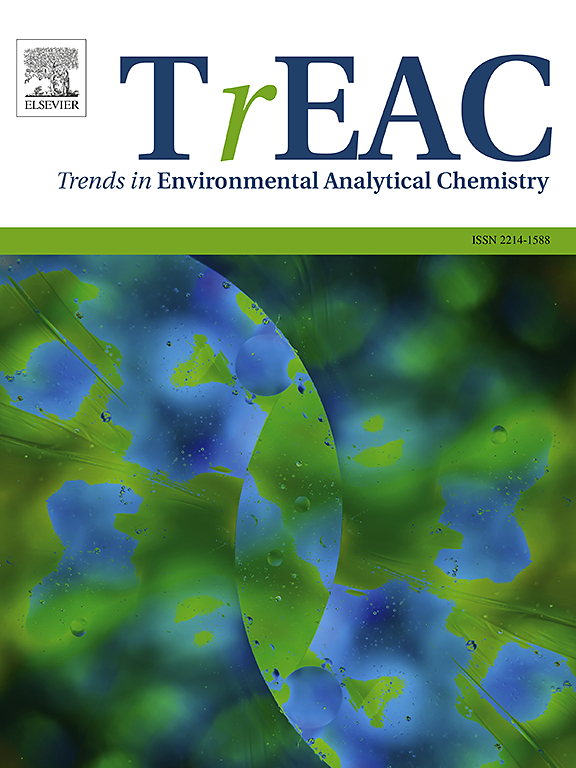基于金属有机框架的电化学传感器用于水生环境中新出现的药物污染物
IF 13.4
2区 化学
Q1 CHEMISTRY, ANALYTICAL
引用次数: 0
摘要
制药产品(PP)在环境中的广泛存在正在成为一个全球性问题,对水生生态系统构成威胁,从而对人类健康构成威胁。这强调需要有效的监测工具,如电化学(生物)传感器,包括先进的(纳米)材料,以提高灵敏度和/或选择性。特别是,金属有机框架(mof)因其高孔隙率、大表面积和可调特性而具有重要价值。尽管在电子导电性和水稳定性方面一直存在挑战,但基于mof的传感器技术已经取得了创新策略。本文综述了基于mof的电化学(生物)传感器在水生环境中检测PP的最新进展,重点介绍了mof的独特属性和克服其局限性的策略。这些数据是根据不同类型的mof (ZIF, UiO, MIL, HKUST,其他不太常见的)来描述的,用于检测27种不同的PP。所有这些研究都是在最近5年内发表的,突出了mof在传感应用中的重要性以及PP污染带来的持续环境挑战。实验证明,基于ZIF-MOF的传感器具有较低的环境足迹,适用于水生生态系统中PP(从fg/L到µg/L)的灵敏、准确测定。mof是一种很有前途的(生物)传感器材料。然而,它们的潜力只能通过移动(生物)传感器超越传统传感器的常规使用,并强调在小型化、便携性和可持续性方面的进步才能充分实现。这些进展对于将基于mofs的电化学(生物)传感器定位为环境分析的首选分析工具和可行的市场解决方案至关重要。本文章由计算机程序翻译,如有差异,请以英文原文为准。
Metal-organic frameworks based electrochemical sensors for emerging pharmaceutical contaminants in the aquatic environment
The widespread presence of pharmaceutical products (PP) in the environment is becoming a global issue, posing a threat to aquatic ecosystems and consequently to human health. This emphasizes the need for effective monitoring tools, such as electrochemical (bio)sensors, comprising advanced (nano)materials to enhance sensitivity and/or selectivity. Particularly, metal-organic frameworks (MOFs) are valuable due to their high porosity, large surface area, and tunable properties. Innovative strategies have been achieved towards MOF-based sensor technology, despite persistent challenges with electron conductivity and water stability. This review discusses the latest developments in MOF-based electrochemical (bio)sensors for detecting PP in the aquatic environment, focusing on the unique attributes of MOFs and strategies to overcome their limitations. Data are described according to the different types of MOFs (ZIF, UiO, MIL, HKUST, other less common), used for detecting 27 different PP. All these studies were published within the last 5 years, highlighting the growing significance of MOFs in sensing applications and the ongoing environmental challenges posed by PP contamination. The reported (bio)sensors proved to be suitable for the sensitive and accurate determination of PP (from fg/L to µg/L) in aquatic ecosystems, with low environmental footprint, especially those based on ZIF-MOF. MOFs are promising materials for the development of (bio)sensors. However, their potential can be fully realized only by moving (bio)sensors beyond the conventional use of traditional transducers and emphasizing advancements in miniaturization, portability, and sustainability. These progresses are essential for positioning MOFs-based electrochemical (bio)sensors as preferred analytical tools in environmental analysis and as viable market solutions.
求助全文
通过发布文献求助,成功后即可免费获取论文全文。
去求助
来源期刊

Trends in Environmental Analytical Chemistry
Chemistry-Analytical Chemistry
CiteScore
21.20
自引率
2.70%
发文量
34
审稿时长
44 days
期刊介绍:
Trends in Environmental Analytical Chemistry is an authoritative journal that focuses on the dynamic field of environmental analytical chemistry. It aims to deliver concise yet insightful overviews of the latest advancements in this field. By acquiring high-quality chemical data and effectively interpreting it, we can deepen our understanding of the environment. TrEAC is committed to keeping up with the fast-paced nature of environmental analytical chemistry by providing timely coverage of innovative analytical methods used in studying environmentally relevant substances and addressing related issues.
 求助内容:
求助内容: 应助结果提醒方式:
应助结果提醒方式:


